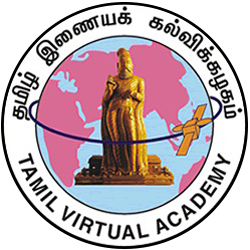Primary tabs
- Poems of Abdul Rahman
Describing the contents and the figures of speech employed in the poems of அப்துல் ரகுமான் this lesson highlights the significant aspects of his poetic imagination. His innovative contributions to புதுக்கவிதை are also described in this lesson.The middle four units present a biographical sketch of கவிஞர் அப்துல் ரகுமான், his poetic principle and content, his creative artistic talents and the novelty introduced in Tamil.
அப்துல் ரகுமான் was born in Madurai, the seat of sangam literature, on 9.11.1937. Right from his early days he was good both in Tamil and Urdu languages. Educated at Thiagarajar College of Madurai, he undertook a research on புதுக்கவிதை and worked as Professor of Tamil for three decades at Islamia College, Vaniyambadi in Tamil Nadu. He lives now in Chennai and continues his creative contributions to Tamil poetry. His poetic ability was developed from the very beginning. His poems reached the people through literary associations, radio broadcasts and poets’ meets organised by social and political organisations.
His கவிராத்திரி is a channel for grooming young poets of புதுக்கவிதை. He was honoured with the title கவிக்கோ. His affinity to Tamil and interest in social development can be observed in his books published by அன்னம் பதிப்பகம்.
His பால்வீதி of 1974 is metaphoric, in cherished and intensified combination of thought and imagination. His form of புதுக்கவிதை removed the fear of decline of Tamil poetry if traditional poetics is not observed in modern poetic compositions. His விலங்குகள் இல்லாத கவிதை meaning unfettered poetry is a sound argument in favour of புதுக்கவிதை.
His poems speak of human progress, religious spirituality, nature, labour, social awareness, music, love and real beauty.
His creativity can be seen in his sharp, clear, beautiful and emotional handling of Tamil words, his formation of new words like அப்பிரசவம், his manipulation of contradictions such as male-female, dark-light and good-bad, his figures of speech used in poems and his novel aspects in comparisons. Imagery is his speciality as ஞாபகங்களின் குப்பைக்கூடை to mean oldage as the dust-bin of memories.
The images he employed were good and effective. It is clear through சாவி இருக்கும் வரை where he uses expessions like ஞாபக முட்கள் as heart beats of isolation or separation in love. Surrealism adopted by him gave birth to பால் வீதி. The musical forms of Arabic and Urdu languages were introduced in Tamil by அப்துல் ரகுமான். The Japanese poetic form of ஹைக்கூ was introduced by him and it is now very popular among modern young Tamil poets and readers.
This lesson is a training ground for enjoying the innovations by கவிக்கோ அப்துல் ரகுமான். You will understand how and why புதுக்கவிதை spreads like wild fire in young minds of imagination and creative ability.


